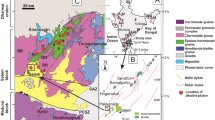Abstract
The Early Cretaceous Sung Valley Ultramafic-Alkaline-Carbonatite (SUAC) complex intruded the Proterozoic Shillong Group of rocks and located in the East Khasi Hills and West Jaintia Hills districts of Meghalaya. The SUAC complex is a bowl-shaped depression covering an area of about 26 km2 and is comprised serpentinised peridotite forming the core of the complex with pyroxenite rim. Alkaline rocks are dominantly ijolite and nepheline syenite, occur as ring-shaped bodies as well as dykes. Carbonatites are, the youngest intrusive phase in the complex, where they form oval-shaped bodies, small dykes and veins. During the course of large scale mapping in parts of the Sung Valley complex, eleven carbonatite bodies were delineated. These isolated carbonatite bodies have a general NW-SE and E-W trend and vary from 20–125 m long and 10–40 m wide. Calcite carbonatite is the dominant variety and comprises minor dolomite and apatite and accessory olivine, magnetite, pyrochlore and phlogopite. The REE-bearing minerals identified in the Sung Valley carbonatites are bastnäsite-(Ce), ancylite-(Ce), belovite-(Ce), britholite-(Ce) and pyrochlore that are associated with calcite and apatite. The presence of REE carbonates and phosphates associated with REE-Nb bearing pyrochlore enhances the economic potential of the Sung Valley carbonatites. Trace-element geochemistry also reveals an enrichment of LREEs in the carbonatites and average ΣREE value of 0.102% in 26 bed rock samples. Channel samples shows average ΣREE values of 0.103 wt%. Moreover, few samples from carbonatite bodies has indicated relatively higher values for Sn, Hf, Ta and U. Since the present study focuses surface evaluation of REE, therefore, detailed subsurface exploration will be of immense help to determine the REE and other associated mineralization of the Sung Valley carbonatite prospect.
Similar content being viewed by others
References
Hornig I., Rare Earth Elements in Sovitic Carbonatites and their Mineral Phases. J. Petrol., 1998, 39, 2105–2121
Bhushan S.K., Kumar A., First Carbonatite Hosted REE Deposit from India. J. Geol. Soc. India, 2013, 81, 41–60
Kumar D., Mamallan R., Dwivedy K. K., Carbonatite magmatism in northeast India. J. Southeast Asian Earth Sci., 1996, 13, 145–158
Srivastava R.K., Sinha A.K., The early Cretaceous Sung Valley ultramafic-alkaline-carbonatite, Shillong Plateau, northeastern India: petrological and genetic significance. Mineral. Petrol., 2004, 80, 241–263
Yusuf S., Sarasvat A.C., A preliminary note on carbonatite of Sung valley, Jaintia Hills district, Meghalaya. Curr. Sci., 1977, 46, 703–704
Chattopadhyay N., Hashimi S., The Sung Valley alkaline-ultramafic-carbonatite, East Khasi and Jaintia Hills districts, Meghalaya. Rec. Geol. Surv. India, 1984, 113, 24–33
Krishnamurthy P., Petrology of the carbonatites and associated rocks of Sung Valley, Jaintia hills district, Meghalaya, India. J. Geol. Soc. India, 1985, 26, 361–379
Acharya S.K., Mitra N.D., Nandy D.R., Regional geology and tectonic setting of northeast India and adjoining region. Mem. Geol. Surv. India, 1986, 119, 6–12
Veena K., Pandey B.K., Krishnamurthy P., Gupta J.N., Pb-, Sr- and Nd-isotopic systematics of the carbonatites of Sung Valley, Meghalaya, northeast India: implications for contemporary plume-related mantle source characteristics. J. Petrol., 1998, 39, 1875–1884
Ray J.S., Pande K., 39Ar-40Ar age of carbonatitealkaline magmatism in Sung Valley, Meghalaya, India. Proc. Indian Acad. Sci., 2001, 110, 185–190
Srivastava R.K., Heaman L.M., Sinha A.K., Shihua S., Emplacement age and isotope geochemistry of Sung Valley alkaline — carbonatite complex, Shillong Plateau, northeastern India: implications for primary carbonate melt and genesis of the associated silicate rocks. Lithos, 2005, 81, 33–54
Melluso L., Srivastava R.K., Guarino, V., Zanetti, A., Sinha, A.K., Mineral compositions and petrogenetic evolution of the Ultramafic-Alkaline-Carbonatite complex of Sung Valley, Northeastern India. Can. Mineral., 2010, 48, 205–229
Ranjith A., Sadiq M., Preliminary search for REE in the peripheral part of Sung ultramafic-alkalinecarbonatite complex, East Khasi Hills & Jaintia Hills district, Meghalaya (G4 Stage). Rec. Geol. Surv. India, 2013, 145–146, 22–28
Krishnamurthy P., Hoda S.Q., Sinha R.P., Banerjee D.C., Dwivedy K.K., Economic aspects of carbonatites of India. J. Asian Earth Sci., 2000, 18, 229–235
Gogoi K., Geological mapping in parts of Kahsi and Jaintia Hills, Meghalaya. Geol. Surv. India, 1972
Chattopadhyay N., Report on the investigation of the Sung Valley Ultramafic-Carbonatite complex, Khasi and Jaitia Hills, Meghalaya. Geol. Surv. India, 1979
Chattopadhyay N., Hashimi S., Report on the investigation of the Sung Valley Ultramafic-Carbonatite complex, Khasi and Jaitia Hills, Meghalaya. Geol. Surv. India, 1981
Chattopadhyay N., Kar S. K., Rajan K.T., Hashimi S., Adhikari K.N., Bora A. K., Final report on the investigation of phosphate in Sung Block, Sung Valley Complex, East Khasi and Jaitia Hills, Districts Meghalaya (F.S.1980–1984 Vol-I). Geol. Surv. India, 1991
Viladkar S.G., Schleicher H., Pawaskar P., Mineralogy and geochemistry of the Sung Valley carbonatite complex, Shillong, Meghalaya, India. Neues Jahrb. Mineral., Monatsh., 1994, H-11, 499–517
Ray J.S., Ramesh R., Pande K., Carbon isotopes in Kerguelen plume-derived carbonatites: evidence for recycled inorganic carbon. Earth Planet. Sci. Lett., 1999, 170, 205–214
Ray J.S., Trivedi J.R., Dayal A.M., Strontium isotope systematics of Amba Dongar and Sung Valley carbonatite-alkaline complexes, India: evidence for liquid immiscibility, crustal contamination and long-lived Rb/Sr enriched mantle source. J. Asian Earth Sci., 2000, 18, 585–594
Sen A.K., Origin of the Sung Valley carbonatite complex, Meghalaya, India: major element geochemistry constraints. J. Geol. Soc. India, 1999, 53, 285–297
Nuinsco Discovers Rare Earth Mineral Ancylite in Prairie Lake Project http://www.azomining.com/News.aspx?newsID=8366
Mining history of bastnaesite http://en.wikipedia.org/wiki/Bastn%C3%A4site
Woolley A.R., Kempe D.R.C., Carbonatite: Nomenclature, average chemical compositions and element distribution. In: Bell K (ed) Carbonatite genesis and evolution. Unwin Hyman, London 1989, 1–14
Evensen N.M., Hamilton P.J., O’Nion R.K., Rare earth abundances in chondritic meteorites. Geochim. Cosmochim. Acta, 1978, 42, 1199–1212
Author information
Authors and Affiliations
Corresponding author
About this article
Cite this article
Sadiq, M., Ranjith, A. & Umrao, R.K. REE mineralization in the carbonatites of the sung valley ultramafic-alkaline-carbonatite complex, Meghalaya, India. cent.eur.j.geo. 6, 457–475 (2014). https://doi.org/10.2478/s13533-012-0191-y
Received:
Accepted:
Published:
Issue Date:
DOI: https://doi.org/10.2478/s13533-012-0191-y



